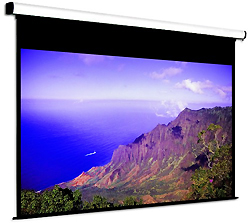A key factor to consider when selecting a projection display is understanding the minimum Total Environmental Dynamic Range required to achieve killer imagery in the target venue.
The term Total Environmental Dynamic Range (TEDR) describes the actual contrast ratio achieved in a venue, including the impact of ambient light.
Thus, the TEDR value defines the dynamic range, or contrast, the viewers actually perceive.
You will see, even in venues with a minimal amount of ambient light, the TEDR value will be much lower than the contrast ratio defined in projector specification sheets.
The method of calculating TEDR is relatively simple:
TEDR = Projector Screen Brightness / (Projector Screen Black Level + Ambient Light reflected by the Screen)
The most complicated part of the process is converting the three values in the formula to one standard of measurement. For purposes of this article, we will use Foot Lamberts (FtL). FtL is a measurement that defines the light being reflected by the screen.
Step 1: Projector Screen Brightness
Convert the lumens produced by the projector to Projector Screen Foot Lamberts (PFL) using the following formula:
PFL = (Projector Lumens / Screen Area in Sq.Ft.) x Screen Gain
Step 2: Projector Black Level
Projector Black Level (PBL) must also be defined in terms of Foot Lamberts. The approximate PBL value can be calculated in terms of lumens, by simply dividing the projector lumen spec by the projector’s specified contrast ratio.
As an example, a 1,000 lumen projector with a 1000:1 contrast ratio, in theory, should produce a PBL of 1 lumen. We then use the same formula we used in step one to convert the lumen-based PBL to a FtL based value (PBFL).
PBFL = (PBL in Lumens / Screen Area in Sq. Ft.) x Screen Gain
Step 3: Ambient Light
For new construction, defining the ambient light that will fall on the screen is best done with the help of the lighting designer.
For existing installations, it’s recommended to take a real-world measurement using an accurate incident light meter positioned where the screen will exist. Hold the meter parallel to the screen surface aimed toward viewers’ position.
Many luminance meters measure incident light in terms of Lux. If this is the case with your meter, the Lux value will need to be converted to Foot Lamberts.
To convert Lux to Foot lamberts, use the following two formulas:
A) Convert ambient incident Lux to Lumens:
Ambient Incident Lumens = Ambient Incident Lux x Screen Area in Sq. Meters
or
Ambient Incident Lumens = Ambient Incident Lux x (Screen Area in Sq Ft / 10.56)
B) Convert Ambient Incident Lumens to Ambient Incident FtL (AIFL)
AIFL = (Ambient Incident Lumens / Screen Area in Sq.Ft.) x Screen Gain
Step 4: Bringing it All Together
Now that all of our variables are expressed in terms of FtL, we can use the formula to calculate the TEDR that will be achieved:
Total Environmental Dynamic Range = Projector Foot Lamberts / (Projector Black Level in FtL + Ambient Incident Light in FtL)
Or, stated in short form, using our acronyms:
TEDR = PFL/(PBFL + AIFL)
Putting Total Environmental Dynamic Range To Work
As an approximate guide, here are some Total Environmental Dynamic Range targets for the application categories listed below:
—Conference Room (PowerPoint, Spreadsheets, some Video or HD): 10-20:1 rear or front-screen
—Worship (Hymn Text, IMAG, some Video): 10-20:1 rear-screen, 20-40:1 front-screen
—Staged events and broadcast applications (CG content, Video and HD): 30-50:1
—Theater or screening room (Video, HD, CG content): at least 500-1000:1
—Home Media and Entertainment (Video, HD, Videogames, Web): at least 15-30:1 rear-screen, 30-50:1 front-screen
Of course, customer preferences and content present additional variables, meaning no simple set of rules will work for every application. However, as you start to consider TEDR in the systems you design, you will define the TEDR values that work best, as well as the projector, screen and lighting configurations that deliver those TEDR values.
It is all about dynamic imagery. The final simple rule: Reduce ambient light as much as possible. If TEDR values are still too low, bring more lumens to the task and consider the use of high gain and/or rear projection screens.
This article provided by Digital Projection.















